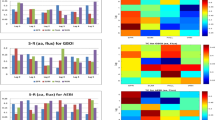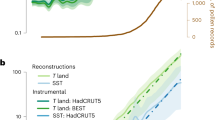Abstract
The complexity of ecosystems can cause subtle1 and chaotic responses to changes in external forcing2. Although ecosystems may not normally behave chaotically3, sensitivity to external influences associated with nonlinearity can lead to amplification of climatic signals. Strong correlations between an El Niño index and rainfall and maize yield in Zimbabwe have been demonstrated4; the correlation with maize yield was stronger than that with rainfall. A second example is the 100,000-year ice-age cycle, which may arise from a weak cycle in radiation through its influence on the concentration of atmospheric CO2 (ref. 5). Such integration of a weak climatic signal has yet to be demonstrated in a realistic theoretical system. Here we use a particular climatic phenomenon—the observed association between plankton populations around the UK and the position of the Gulf Stream6,7—as a probe to demonstrate how a detailed marine ecosystem model extracts a weak signal that is spread across different meteorological variables. Biological systems may therefore respond to climatic signals other than those that dominate the driving variables.
This is a preview of subscription content, access via your institution
Access options
Subscribe to this journal
Receive 51 print issues and online access
$199.00 per year
only $3.90 per issue
Buy this article
- Purchase on Springer Link
- Instant access to full article PDF
Prices may be subject to local taxes which are calculated during checkout




Similar content being viewed by others
References
Mysterud, A., Stenseth, N. C., Yoccoz, N. G., Langvain, R. & Steinhelm, G. Nonlinear effects of large-scale climatic variability on wild and domestic herbivores. Nature 410, 1096–1099 (2001).
Sugihara, G., Grenfell, B. & May, R. M. Distinguishing error from chaos in ecological time series. Phil. Trans. R. Soc. Lond. B 330, 235–251 (1990).
Berryman, A. A. & Millstein, J. A. Are ecological systems chaotic—and if not, why not? Trends Evol. Ecol. 4(1), 26–28 (1989).
Cane, M. A., Eshel, G. & Buckland, R. W. Forecasting Zimbabwean maize yield using eastern equatorial Pacific sea surface temperature. Nature 370, 204–205 (1994).
Shackleton, N. J. The 100,000-year ice-age cycle identified and found to lag temperature, carbon dioxide and orbital eccentricity. Science 289, 1897–1902 (2000).
Taylor, A. H., Colebrook, J. M., Stephens, J. A. & Baker, N. G. Latitudinal displacements of the Gulf Stream and the abundance of plankton in the north-east Atlantic. J. Mar. Biol. Assoc. UK 72, 919–921 (1992).
Taylor, A. H. North-south shifts of the Gulf Stream and their climatic connection with the abundance of zooplankton in the UK and its surrounding seas. ICES J. Mar. Sci. 52, 711–721 (1995).
Glover, R. S. The continuous plankton recorder survey of the North Atlantic. Symp. Zool. Soc. Lond. 19, 189–210 (1967).
Frid, C. L. J. & Huliselan, N. V. Far field control of long term changes in Northumberland (NW North Sea) coastal zooplankton. ICES J. Mar. Sci. 53(6), 972–977 (1996).
Taylor, A. H. in Changing States of Large Marine Ecosystems of the North Atlantic (eds Sherman, K. & Skjoldal, H.-R.) (in the press).
George, D. G. The impact of regional-scale changes in the weather on long-term dynamics of Eudaptomus and Daphnia in Esthwaite Water, Cumbria. Freshwat. Biol. 45, 111–121 (2000).
George, D. G. & Taylor, A. H. UK lake plankton and the Gulf Stream. Nature 378, 139 (1995).
Hurrell, J. W. Decadal trends in the North Atlantic Oscillation: regional temperatures and precipitation. Science 269, 67600679 (1995).
Allen, J. I., Blackford, J. C. & Radford, P. J. A 1-D vertically resolved modelling study of the ecosystem dynamics of the middle and southern Adriatic Sea. J. Mar. Sys. 18, 265–286 (1998).
Allen, J. I., Howland, R. M. H., Bloomer, N. & Uncles, R. J. Simulating the spring phytoplankton bloom in the Humber Plume, UK. Mar. Poll. Bull. 37, 295–305 (1999).
Baretta, J. W., Ebanhoh, W. & Ruardij, P. (eds) The european regional seas ecosystem model II. J. Sea Res. 38(3/4), 229–483 (1997).
Blumberg, A. F. & Mellor, G. L. in Mathematical Modelling of Estuarine Physics (Proc. Int. Symp. Hamburg, 1978) (eds Sunderland & Holtz) 203–214 (Springer, Berlin, 1980).
Taylor, A. H. North-south shifts of the Gulf Stream: ocean-atmosphere interactions in the North Atlantic. Int. J. Climatol. 16, 559–583 (1996).
Colebrook, J. M. Continuous plankton records: overwintering and annual fluctuations in the abundance of zooplankton. Mar. Biol. 84, 261–265 (1985).
Huisman, J., van Oostven, P. & Weissing, F. J. Critical depth and critical turbulence: Two different mechanisms for the development of phytoplankton blooms. Limnol. Oceanogr. 44(7), 1781–1787 (1999).
Ebenhöh, W., Baretta, J. W. & Baretta-Bekker, J. G. The primary production module in a marine ecosystem model ERSEM II. J. Sea Res. 38, 173–194 (1997).
Droop, M. R. The nutrient status of algal cells in continuous culture. J. Mar. Biol. Assoc. UK 54, 825–855 (1974).
Baretta-Bekker, J. G., Baretta, J. W., Hansen, A. S. & Riemann, B. An improved model of carbon and nutrient dynamics in the microbial food web in marine enclosures. Aquat. Microb. Ecol. 14, 91–108 (1998).
Broekhuizen, N. R., Heath, M. R., Hay, S. G. & Gurney, S. C. Modelling the dynamics of the North Sea's mesozooplankton. Neth. J. Sea Res. 33, 381–406 (1995).
Acknowledgements
We wish to thank J. Stephens and J. Dearman for assisting with the calculations. B. Clarke provided statistical advice. A.H.T. is a Fellow of the Sir Alister Hardy Foundation for Ocean Science, which provided the plankton data. This work is part of the Core Strategic Programme of Plymouth Marine Laboratory.
Author information
Authors and Affiliations
Corresponding author
Ethics declarations
Competing interests
The authors declare that they have no competing financial interests
Rights and permissions
About this article
Cite this article
Taylor, A., Allen, J. & Clark, P. Extraction of a weak climatic signal by an ecosystem. Nature 416, 629–632 (2002). https://doi.org/10.1038/416629a
Received:
Accepted:
Issue Date:
DOI: https://doi.org/10.1038/416629a
This article is cited by
-
Absence of the Great Whirl giant ocean vortex abates productivity in the Somali upwelling region
Communications Earth & Environment (2024)
-
Trait-based approach revealed the seasonal variation of mesozooplankton functional groups in the South Yellow Sea
Marine Life Science & Technology (2023)
-
Characteristics of zooplankton community in North Yellow Sea unveiled an indicator species for the Yellow Sea Warm Current in winter: Euchaeta plana
Journal of Oceanology and Limnology (2020)
-
Contrasting patterns of native and non-native plants in a network of protected areas across spatial scales
Biodiversity and Conservation (2020)
-
Variation of Zooplankton Ecological Group During Spring in China Estuaries
Journal of Ocean University of China (2019)
Comments
By submitting a comment you agree to abide by our Terms and Community Guidelines. If you find something abusive or that does not comply with our terms or guidelines please flag it as inappropriate.



